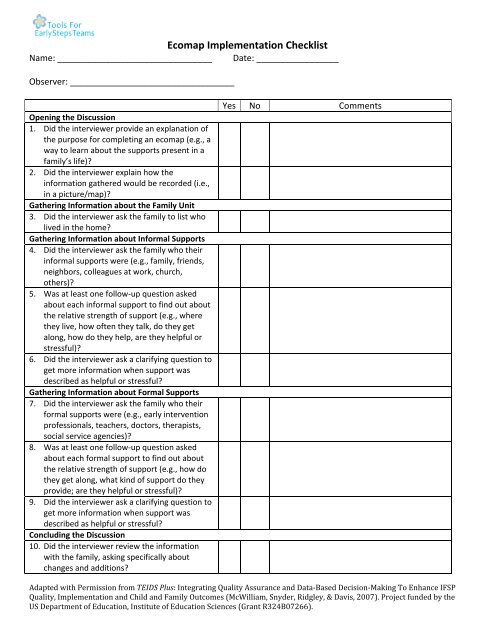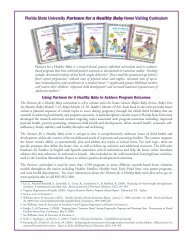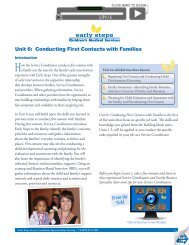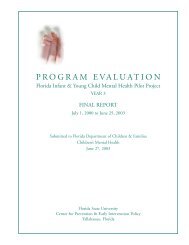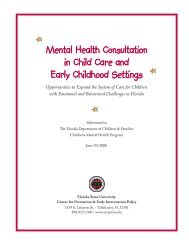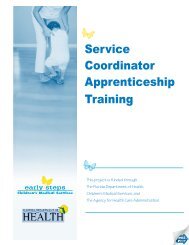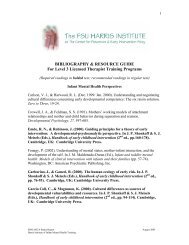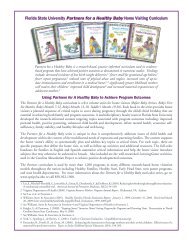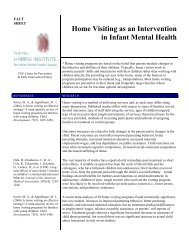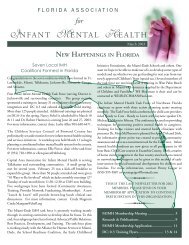Ecomap Implementation Checklist
Ecomap Implementation Checklist
Ecomap Implementation Checklist
Create successful ePaper yourself
Turn your PDF publications into a flip-book with our unique Google optimized e-Paper software.
<strong>Ecomap</strong> <strong>Implementation</strong> <strong>Checklist</strong> <br />
Name: ________________________________ Date: _________________ <br />
Observer: __________________________________ <br />
Opening the Discussion <br />
1. Did the interviewer provide an explanation of <br />
the purpose for completing an ecomap (e.g., a <br />
way to learn about the supports present in a <br />
family’s life)? <br />
2. Did the interviewer explain how the <br />
information gathered would be recorded (i.e., <br />
in a picture/map)? <br />
Gathering Information about the Family Unit <br />
3. Did the interviewer ask the family to list who <br />
lived in the home? <br />
Gathering Information about Informal Supports <br />
4. Did the interviewer ask the family who their <br />
informal supports were (e.g., family, friends, <br />
neighbors, colleagues at work, church, <br />
others)? <br />
5. Was at least one follow-‐up question asked <br />
about each informal support to find out about <br />
the relative strength of support (e.g., where <br />
they live, how often they talk, do they get <br />
along, how do they help, are they helpful or <br />
stressful)? <br />
6. Did the interviewer ask a clarifying question to <br />
get more information when support was <br />
described as helpful or stressful? <br />
Gathering Information about Formal Supports <br />
7. Did the interviewer ask the family who their <br />
formal supports were (e.g., early intervention <br />
professionals, teachers, doctors, therapists, <br />
social service agencies)? <br />
8. Was at least one follow-‐up question asked <br />
about each formal support to find out about <br />
the relative strength of support (e.g., how do <br />
they get along, what kind of support do they <br />
provide; are they helpful or stressful)? <br />
9. Did the interviewer ask a clarifying question to <br />
get more information when support was <br />
described as helpful or stressful? <br />
Concluding the Discussion <br />
10. Did the interviewer review the information <br />
with the family, asking specifically about <br />
changes and additions? <br />
Yes No Comments <br />
Adapted with Permission from TEIDS Plus: Integrating Quality Assurance and Data-‐Based Decision-‐Making To Enhance IFSP <br />
Quality, <strong>Implementation</strong> and Child and Family Outcomes (McWilliam, Snyder, Ridgley, & Davis, 2007). Project funded by the <br />
US Department of Education, Institute of Education Sciences (Grant R324B07266).
11. Did the interviewer tell the family what would <br />
happen with the information (e.g., shared with <br />
team, used for IFSP development)? <br />
12. Did the interviewer offer a copy of the <br />
information to the family? <br />
13. Did the interviewer thank the family for <br />
participating? <br />
Interview Style <br />
14. When discussing informal supports, did the <br />
interviewer initially use open-‐ended questions <br />
to gain an understanding? <br />
15. When discussing formal supports, did the <br />
interviewer initially use open-‐ended questions <br />
to gain an understanding? <br />
16. Did the interviewer ask clarifying questions to <br />
confirm all supports (i.e., formal and informal) <br />
had been included? <br />
17. Did the interviewer avoid using the words, <br />
“formal” and “informal”? <br />
18. Did the interviewer maintain focus without <br />
attending to distractions? <br />
19. When an interruption occurred, did the <br />
interviewer return easily to the discussion? <br />
20. Did the interviewer use appropriate affect <br />
(facial expressions, tone of voice)? <br />
21. Did the interviewer use affirming behaviors <br />
(nodding, positive comments, gestures)? <br />
22. Did the interviewer use active listening <br />
techniques (rephrasing, clarifying, <br />
summarizing)? <br />
23. Did the interviewer act in a nonjudgmental <br />
way throughout the discussion? <br />
Drawing the Picture <br />
24. Did the interviewer use a piece of paper to <br />
record the information? <br />
25. Did the interviewer position the paper so the <br />
family could see/read the information as it <br />
was written? <br />
26. Did the interviewer record the family unit in <br />
the middle of the ecomap? <br />
27. Did the interviewer record informal supports <br />
above the family unit? <br />
28. Did the interviewer record formal supports <br />
below the family unit? <br />
29. Were lines drawn between each support and <br />
the family unit to reflect the relative strength <br />
of support? <br />
Yes No Comments <br />
Adapted with Permission from TEIDS Plus: Integrating Quality Assurance and Data-‐Based Decision-‐Making To Enhance IFSP <br />
Quality, <strong>Implementation</strong> and Child and Family Outcomes (McWilliam, Snyder, Ridgley, & Davis, 2007). Project funded by the <br />
US Department of Education, Institute of Education Sciences (Grant R324B07266).


